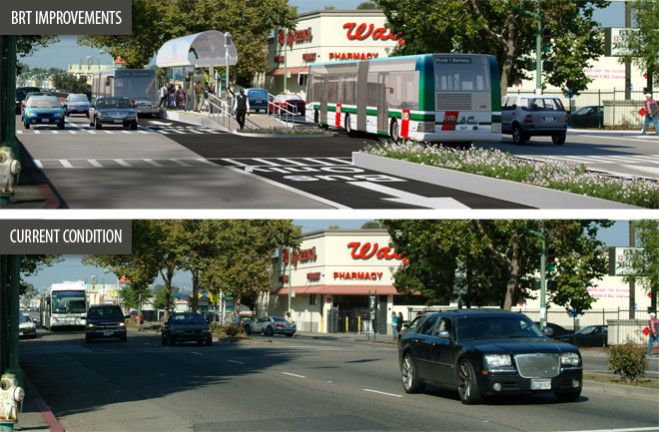Oakland City Council Gives Final Approval to East Bay BRT
4:21 PM PDT on July 18, 2012
The Oakland City Council on Tuesday unanimously approved the 9.5-mile East Bay Bus Rapid Transit line that will run from downtown Oakland to San Leandro. The vote in Oakland follows a similar approval by San Leandro’s City Council on Monday.
The dual approvals mark a huge victory for advocacy groups and AC Transit, which first recommended BRT in 2001 as way to improve transit options on heavily traveled corridors. The East Bay BRT is expected to be completed in 2016 at a cost of between $152 million and $172 million, and will include seven miles of dedicated bus lanes in Oakland along International Boulevard with 33 stops, most located no more than one-third of a mile apart. Once finished, it will be one of the longest BRT routes in the country, and one of the few constructed in such a densely populated urban area.
“It’s tremendously significant,” said Joél Ramos, a community planner with TransForm. “It’s an indication of Oakland being a forward-thinking city… improving infrastructure to make travel, conducting business, accessing services, or even living along the corridor, more sustainable, more enjoyable, and more liveable.”
Before the vote, Tina Spencer, Oakland's director of planning and service development, told the council: “The issue is slower transit, and it really creates an unsustainable condition. It’s a downward spiral. More congestion equals more delay, which contributes to unreliable service, fewer riders, which leads to less revenue, fewer riders and finally, service cuts.”
International Boulevard is one of the busiest and most important corridors in Oakland, with many homes and businesses, as well as near-by hospitals and medical centers, civic centers, shopping complexes and churches.
The bus routes that serve the area are the 1 and 1R. With 25,000 riders a day -- one-tenth of AC Transit’s total ridership -- they rank among the agency’s top five busies. But for the people who rely on them, the 1 and 1R are a huge source of frustration, with inconsistent and crowded service. Once completed, BRT is expected to relieve that frustration by increasing average bus speeds from 9 mph to 13 mph. During the week, buses will be scheduled to run every five minutes during the day and every 10 minutes at night. The more consistent service is expected to increase ridership by 70 percent, to 17,100 patrons per day by 2035. That, in turn, is projected to reduce car travel by 11,300 miles per day.
The BRT corridor will begin at 20th Street in downtown Oakland and run to the San Leandro BART station on the northern edge of San Leandro. AC Transit has promised to continue reaching out to residents and businesses along the route.
In addition to dedicated bus lanes, the route will also include traffic signal systems that hold green lights for approaching buses. Plans also include street improvements, such as new bike lanes, center medians, crosswalks and lighting at every stop. Supporters say these changes will help reduce crime in an area that sorely needs help, and benefit public health.
As Celia Harris, project director with Human Impact Partners, an organization that assess the public health impact of transportation policies, told the Oakland City Council:
First, BRT is likely to bring in other economic development as others cities have seen…and if that happened here, it would lead to more retail and jobs for East Oakland… Second, a well-lit BRT line, running in the middle of International Blvd. will increase visibility of people waiting for the bus, and also attract more riders. Both of these will lead to more eyes on the street, which are likely to decrease crime… Thirdly, the BRT line will improve health by reducing collision-related injuries and death, and encouraging more physical activity.
The final project is a scaled-back version of the original plan, which was to run from downtown Berkeley to San Leandro. Berkeley was dropped from the project when local merchants objected to the loss of parking.
To win approval in Oakland and San Leandro, AC Transit modified the plan to accommodate input from residents and businesses. One big change is that the new buses that will load passengers from either the right or left sides. This means buses can stop from either direction at a central, elevated platform in dedicated BRT lanes, which leaves the curb lanes for parking.
There will still be a loss of parking to construct the dedicated BRT lanes, though Ramos of TransForm said it leaves the majority of spaces intact, and much of what exists is underutilized. AC Transit has promised to work with merchants in the San Antonio, Fruitvale and Elmhurst neighborhoods, the three neighborhoods facing the highest impact, to supplement the area with additional parking.
The mood of the City Council was tense right up until the vote, with objections to the loss of parking and concerns about AC Transit’s efforts to guarantee local jobs. The East Bay BRT is predicted to generate between 500 and 700 jobs. Council members voted to introduce an amendment that called for the encouragement of “prime and subcontractors to voluntarily hire Oakland residents.” They also added an amendment that calls for the compensation of businesses that suffer losses during construction due to loss of parking.
Stay in touch
Sign up for our free newsletter




